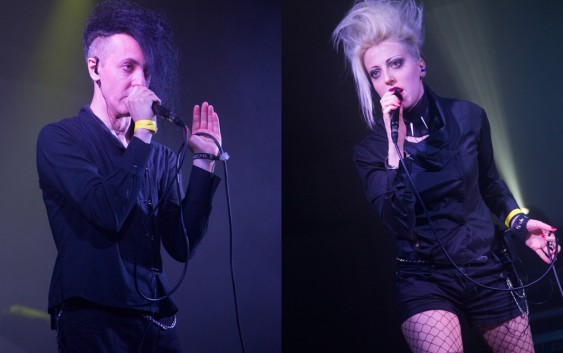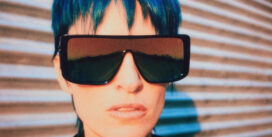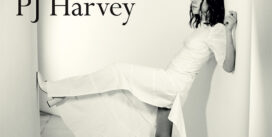On the 20th of February I finally had the opportunity to see the Italian band The Frozen Autumn playing live in London. They made such a great impact on me that night and many years before, as I discovered their music to be the cure both for my ears and soul.
The Frozen Autumn started as a solo project of Diego Merletto as the singer, keyboardist and synth programmer in 1993. It was characterized by melodic and atmospheric dark wave sound, later tried to be described also as goth wave, cold wave and by many other names, since it appeared almost impossible to put a finger on the particular sound the band was creating. Soon Diego introduced the guitarist Claudio Brosio, and some years later, after forming a side project Static Movement with Arianna aka Froxeanne (also vocals, keyboards and synth), she soon became the permanent member of The Frozen Autumn and although changing members throughout the years Diego and Froxeanne have been working together ever since.
So in this interview I would like to bring all of their fans and those who have yet to become fans, closer to their exceptional work.
- Your music has been described as dark wave, gothic wave, cold wave, but maybe frozen wave describes it best. What is frozen wave and how would you describe your music?
TFA: “Frozen wave” in our intention, literally standing for “ice-cold wave” or “colder than cold wave” so to speak. It describes our unique way of making electro-cold-wave music.
- We can relate your music to some influences, yet you managed to keep your creations unique. But what was the driving power, the motivation in the early days that would later shape and continue shaping your sound?
TFA: Something in our genetic make-up, something flowing in our veins is what has been leading us so far to make this kind of music without ever thinking of giving up. We’ve always felt the urge of expressing a peculiar something through synth programming, sound research, sequences layering etc. We’ve always had something to convey and we knew the only way we could have ever done that was through this particular sound.
- When listening to Pale Awakenings, your first album released in 1995, I found it to be rather atmospheric and even ethereal. What changed only 2 years later?
TFA: New sensations, new gear, new things to say. A step further in our sound evolution, that’s it.
- With each album you bring something new. So what shift did you make on Emotional Screening Device?
TFA: Well, no guitar whatsoever, pure electro sound thanks to the great experience that our spin-off project album “Visionary Landscapes” was. Massive four-hand-programming and composition, more female vocals and of course again, new gear and new sources of inspiration.
- After “Is Anybody there?” released in 2005, the great “Chirality” album was released in 2011. Were you busy with some other project or collaborations in the meantime?
TFA: We were very busy with our personal lives, moving from one town to another with a discouraging frequency, which affected our band activity. In the meantime we re-released our early back catalogue, issued a double-DVD whose title is “Seen From Under Ice” which was a very long work indeed and a 10″ vinyl EP called “Rallentears”. We then collaborated for some guest-singing and remixes and founded Calembour Records.
- Can you pick some influential bands that inspired you, or artists in general?
TFA: Well, all the 80’s bands from the 4AD label, along with acts like Twice A Man, Sad Lovers And Giants, Legendary Pink Dots, Chameleons, John Foxx etc.
- I am sure fans have their favorite songs. Do you favor some of your songs over others?
TFA: We could favor some songs only in relation of how “functional” they could be within a live gig. Then of course we may feel more affectionate to some rather than to some others, but that has nothing to do with how we like the songs themselves, but maybe just to the way we felt when we composed them.
- You, Diego and Froxeanne, look like a perfect match. Even though other people were involved in the band over the years you two stick together. So is it a good creative combination or a mutual understanding and good personality match as well?
TFA: The other people involved were just mere session men that never had any role in composition or in the band’s decisions. Their task was mostly, or entirely, limited to the live stage performances. The core of TFA has always been Diego alone or Diego & Froxeanne. We’ve been collaborating together since we met in March 1996 and haven’t stopped since. It’s mostly a good creative combination. We really get along very well as far as making music is concerned and have always tried to be helpful to each other.
- For all of us wondering how these songs that we love so much have been created, please tell us how one working day looks for the two of you.
TFA: Waking up, PR on the internet, live gig scheduling supervising, bureaucracy stuff tied to cd selling, synth programming, briefings on the phone, studio settling, merch devising, answering to e-mails/interviews, rehearsing, DIY stuff, going to bed. We didn’t have to mention uncool things such as house cleaning, did we ? 😉
- How do you divide the work of composing and writing the lyrics?
TFA: There’s no precise way in which we do that. But normally we create the music before writing the lyrics.
- Tell us about your gigs. We know that you play abroad a lot. Do you have a special place you like to travel, where is the heart of your fan base?
TFA: We like travelling in any place where our fans are. As far as we can see from the various music download and social network statistics, cd sales etc. the heart of our fan base is in Italy, Germany and in the Americas.
- Do you have some particularly bizarre or funny story from your gigs and travels you’d like to share?
TFA: We have many but they’re all too long and we wouldn’t like to choose one place to the detriment of another, because all of the times we have had some problems or adventures it was never the audience’s fault. But one day, we may collect all of these stories together, who knows…
- Is there a large “gothic” scene in Italy? Froxeanne, you are also involved as a DJ, please tell us more about that.
Froxeanne: The goth/alternative scene in Italy has for many aspects nothing to envy of many other European countries’ scene. Our clubs are on average more elegant than what I generally see around. I do DJ quite often but also Diego does, and it’s a cool side-activity, I must say, even though my most natural place will always be the stage, rather than a console.
- Diego, how about your passion for video art?
Diego: It’s an old passion of mine dating back to the early 90´s. I think matching music to some visuals make the whole thing much more complete and interesting. This is why I thought of having self-made audio synchronized background videos on stage, to create an atmosphere that could suit our music in every situation.
- Recently you have released a brand new EP “Lie in Wait”, tell us something about your new material.
TFA: It’s a 12″ 45rpm picture vinyl limited to just 500 hand-numbered copies, containing 3 completely unreleased tracks + a new remix of the reknown song “Sidereal Solitude”, contained in “Chirality”. We think this marks a further evolution in our composing procedure and bridges the distance between “Chirality” and our new full-length album, on which we’re already working.
- Froxeanne, can you shortly introduce Calembour Records?
I founded it in 2010 and it’s basically an independent record label focused on electro wave, cold wave and alternative electro music produced by Italian artists such as us, Hidden Place and Femina Faber. Calembour Records’ releases are distributed worldwide both in physical and digital media.
- Let me go back to my impression from the gig. On stage you manage to provide great quality performance and show a lot of emotions as well. Has music that is your profession also remained your greatest joy? Do you still feel today the same passion and enthusiasm for creating and performing as in the early days?
TFA: Thanks for your words. We think that our enthusiasm and passion in creating music is always the same, but as far as live performing is concerned, well, we feel even more enthusiastic about it now than in the past.
Interview and photo: Marija Buljeta




